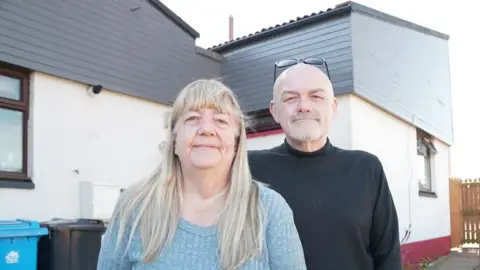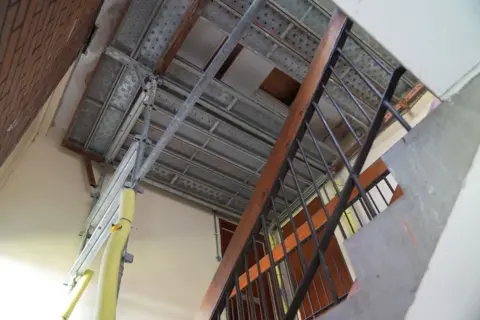'RAAC in our roof has robbed us of our retirement'
 BBC
BBCA Dundee couple have said they feel "robbed" of their retirement plans after a cheap version of concrete was found in their home.
Claire Neill, 55, and Chris Hughes, 54, were shocked to receive a letter saying their bungalow in Whitfield contained reinforced autoclaved aerated concrete (RAAC), leaving them facing a potentially hefty repair bill.
Almost 900 households in Dundee, the highest number in Scotland, are believed to contain the substance. It was used mostly in flat roofing but also in floors and walls between the 1950s and 1990s.
The couple own their property, meaning they will be liable for any repairs needed as a result.
Mr Hughes said evidence of their cottage having RAAC was visible in their bedroom and office.
He said: "We're in a kind of limbo, and it's been really hard because of our retirement, it had been what we were waiting for."

Ms Neill's son had gifted her the money to buy the bungalow, which she had planned as a retirement home.
"I feel robbed," she said. "It was the perfect house, nothing was wrong with it, the home report was fine.
"We've been assured it won't fall on us while we're sleeping, but how long do we wait?
"This was my forever house."
Ms Neill said she had been hoping to reduce her hours at work, but the situation at home meant the future was uncertain.
"We don't know now if that's even going to be an option, we might lose our house and have to go and get another mortgage," she said.
Dundee City Council said it had carried out hundreds of inspections across the city, and found RAAC present in 81 blocks of flats and 293 cottages.
Of these, 79 blocks of flats have council tenants or are mixed tenure, and 172 cottages have council tenants.
It said 526 council tenants were affected, with the rest private homeowners.
The authority said the "vast majority" of properties affected "did not present an immediate safety issue" as the RAAC was in a satisfactory condition.
A spokesman said: "The council has an intervention strategy in place to remediate affected properties, if the RAAC shows evidence of decline.
"Where properties are privately owned, responsibility for maintenance lies with owners who are recommended to seek their own advice regarding the condition of RAAC present within their property."

While council tenants will have repair costs covered, private homeowners like Nigel Kestell will be liable for the cost of repairs.
Mr Kestell, 65, bought his Menzieshill flat almost 30 years ago but recently discovered the building contains RAAC.
"I was hoping to retire in four weeks' time, but I've put it on hold because it's being bandied about that repairs are going to be quite expensive," he said.
"I'm still quite fit, so I feel I can go on working until there's some certainty about what's actually going to happen with us.
"There's nothing in my power that I can do apart from go on top of the roof and put something on them myself, and that's not going to happen at my age."

Mr Kestell said some concrete had already fallen off the roof, leading to the council erecting scaffolding as some of the flats in the block are owned by the local authority.
He said: "There are a lot of professionals that know an awful lot about this now, so I do feel the knowledge is there and there are probably solutions for it.
"If we don't do anything now, then there's probably going to be a tsunami of people in Dundee that are going to need somewhere to live."

Campaigner Yvette Hoskins, 49, lives with her husband Wayne and their two children in Craigie Drive, one of five areas in the city where RAAC has been identified in properties.
The family were selling their flat when the material was found in the block's roof - the buyers could not get a mortgage and the sale fell through.
Ms Hoskins said: "We had a limited budget. We bought this as first-time buyers knowing that eventually we wanted to buy a house, with the garden, for the children.
"I made a promise to them that we would be in another home by last year and that hasn't happened."
Ms Hoskins was asked to be part of the UK RAAC campaign group and recently gave evidence to the Scottish Parliament's housing committee, outlining the local situation.
She is calling for a national fund to address the issue, both for people in council and privately-owned properties.
"They need that support network to let them know that they're not on their own and there are people out there in the same position," she said.
'Worrying time'
Housing Minister Paul McLennan said the Scottish government recognised it was a "worrying time for homeowners who have concerns about RAAC".
He said: "While homeowners are responsible for their own building maintenance costs, local authorities can provide advice on what support may be available.
"That support may include advice, guidance, and information on potential sources of funding.
"The Scottish government takes RAAC very seriously and we continue to work closely with local authorities and social housing providers."
He added: "We have also established regular meetings with public and private sector bodies to ensure best practice is shared across sectors impacted by RAAC.
"We continue to urge the UK government to make additional funding available but to date they have refused to do so."
